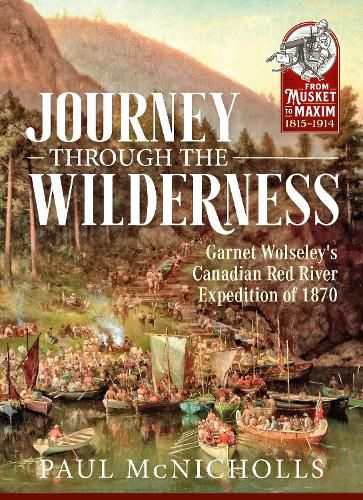Readings Newsletter
Become a Readings Member to make your shopping experience even easier.
Sign in or sign up for free!
You’re not far away from qualifying for FREE standard shipping within Australia
You’ve qualified for FREE standard shipping within Australia
The cart is loading…






In the spring of 1870 an Anglo-Canadian military force embarked on a 1,200 mile journey, half of which would be through the wilderness, bound for the Red River Settlement, the sight of present day Winnipeg. At the time the settlement was part of the vast Hudson’s Bay Company controlled territories which Canada was in the process of purchasing. Today Canada is the second largest country in the world, but at the time it was a recent creation made up of three British North American colonies. The British government of the day, focussed on financial retrenchment and anchored on anti-imperialist values, would have happily severed its ties with its North American colonies. The dynamic American republic, resurgent after the cataclysm of the Civil War, aspired to take control of all of the British North American territories, including Canada and the Hudson’s Bay Company lands. Canadian Prime Minister John A. Macdonald knew that for his new country to survive and prosper it would have to expand across the continent and incorporate the Hudson’s Bay Company’s lands, and ultimately the colony of British Columbia on the Pacific Ocean as well. The HBC was in decline and wanted to give up the responsibility for its vast territories. Macdonald would have preferred Britain to take on this responsibility until Canada was ready, but Westminster was unwilling. Ready or not, Canada would have to act or risk the United States getting in ahead of them. In all of this, the interests of the indigenous people received scant consideration, and this included the residents of the Red River Settlement. The population here, about 14,000 strong, was mostly comprised of the descendants of the Kildonan Scots, farmers who had arrived under the auspices Lord Selkirk earlier in the century, the mixed race descendants of English speaking HBC workers and First Nations women, and the mixed race descendants of French speaking North West Company workers and First Nations women. The latter group, known as the Metis, had long before the time of Canada’s pending takeover developed a distinct cultural identity, referring to themselves as A New Nation . 20 illustrations, 9 maps
$9.00 standard shipping within Australia
FREE standard shipping within Australia for orders over $100.00
Express & International shipping calculated at checkout
In the spring of 1870 an Anglo-Canadian military force embarked on a 1,200 mile journey, half of which would be through the wilderness, bound for the Red River Settlement, the sight of present day Winnipeg. At the time the settlement was part of the vast Hudson’s Bay Company controlled territories which Canada was in the process of purchasing. Today Canada is the second largest country in the world, but at the time it was a recent creation made up of three British North American colonies. The British government of the day, focussed on financial retrenchment and anchored on anti-imperialist values, would have happily severed its ties with its North American colonies. The dynamic American republic, resurgent after the cataclysm of the Civil War, aspired to take control of all of the British North American territories, including Canada and the Hudson’s Bay Company lands. Canadian Prime Minister John A. Macdonald knew that for his new country to survive and prosper it would have to expand across the continent and incorporate the Hudson’s Bay Company’s lands, and ultimately the colony of British Columbia on the Pacific Ocean as well. The HBC was in decline and wanted to give up the responsibility for its vast territories. Macdonald would have preferred Britain to take on this responsibility until Canada was ready, but Westminster was unwilling. Ready or not, Canada would have to act or risk the United States getting in ahead of them. In all of this, the interests of the indigenous people received scant consideration, and this included the residents of the Red River Settlement. The population here, about 14,000 strong, was mostly comprised of the descendants of the Kildonan Scots, farmers who had arrived under the auspices Lord Selkirk earlier in the century, the mixed race descendants of English speaking HBC workers and First Nations women, and the mixed race descendants of French speaking North West Company workers and First Nations women. The latter group, known as the Metis, had long before the time of Canada’s pending takeover developed a distinct cultural identity, referring to themselves as A New Nation . 20 illustrations, 9 maps